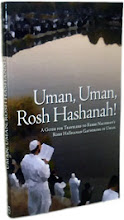 Breslover Chassidim are accustomed to retell this story during the “Baal Shem Tov Se’udah,” which is the last meal of Acharon shel Pesach (AKA “ne’ilas ha-chag”). This was a common custom among many Chassidim in Europe, and a few such as the Skolye Chassidim still tell the story. This version is based on the Breslov mesorah.
Breslover Chassidim are accustomed to retell this story during the “Baal Shem Tov Se’udah,” which is the last meal of Acharon shel Pesach (AKA “ne’ilas ha-chag”). This was a common custom among many Chassidim in Europe, and a few such as the Skolye Chassidim still tell the story. This version is based on the Breslov mesorah.Dovid Sears
Reb Levi Yitzchok Bender, the central figure in the Meah Shearim Breslov kehillah after World War II until his passing in 1989, used to retell the story every year on Acharon shel Pesach. He always said that he retold the story the way he received it personally from Rabbi Shimshon Barsky of Uman, a grandson of Rebbe Nachman and a leading mashpiya during the late late 1800s-early 1900s. However, Reb Levi Yitzchok also said that once someone asked his teacher Reb Avraham b’Reb Nachman if Reb Shimshon’s version was accurate. He answered, “S’iz doh nuschos ... There are many versions!” (Heard from Rabbi Avraham Shimon Burshteyn). Like all oral traditions, there are a few differences over this detail or that. Yet these differences are relatively minor.
We have put together this brief outline so that at least something will be available in English for those who wish to tell the story during the final hours of Acharon shel Pesach. This is not an “official” version, but we hope it will be good for starters.
Beginning the Journey
The Baal Shem Tov experienced intense gagu’im to travel to Eretz Yisrael—until at last the time came. (This mystical understanding of traveling to Eretz Yisrael is echoed by Rebbe Nachman’s statement, “With every step, I’m going to Eretz Yisrael,” and his teaching that “all tefillos and avodahs ascend through Eretz Yisrael.” Just as Eretz Yisrael was the goal of the Exodus from Egypt, so in a mystical sense it represents the goal of the spiritual quest of each individual and the Jewish people collectively. See the Breslov teachings in the Tcheriner Rov’s anthology, Otzar HaYirah, “Eretz Yisrael.”)
The Baal Shem Tov took his only daughter, the tzaddekes Udel, and his chassid Reb Hirsch Sofer, as companions for the journey.
It was very unusual to go to Eretz Yisrael in those days, and extremely difficult—unlike today. But he trusted in Hashem and left home with only enough money to reach the next town. (It is well-known that the Baal Shem did not keep even a small coin overnight, but lived from day to day, trusting completely in Hashem.) He was confident that Hashem would make a way for him.
(When Rabbi Shmuel Breines tells the story in the Breslov Shtibel of Borough Park, he often stresses the importance of bitachon, total reliance upon Hashem. Two sources of inspiring teachings about bitachon are Rabbi Avraham ben HaRambam’s Sefer HaMaspik: Shaar HaBitachon, or Rabbenu Bachya Ibn Paquda’s Chovos HaLevavos: Shaar HaBitachon. A quote or two from such sources can help make the story more meaningful.)
Day by day and week by week the threesome traveled from one town to the next, heading toward the port city of Istanbul on the Black Sea. Somehow the Baal Shem Tov received enough money to keep traveling, until they arrived in Istanbul on Erev Pesach.
They had neither provisions nor money for lodgings. But the Baal Shem Tov was sure that everything would work out satisfactorily. They found an inn in the Jewish quarter of the city and took lodgings on the ground floor, where the horses were stabled. Udel went to shore to wash clothes for Yom Tov, while her father and Reb Hirsch went to a nearby Beis HaMidrash.
At the same time, a wealthy childless couple from Germany arrived in Istanbul. This couple had been following the Baal Shem Tov from town to town in order to obtain his brochah, and only caught up to him now. Bi-hashgochah pratis, they wound up at the same inn, where they rented a large suite of rooms, and bought matzos, wine and food for Pesach. Then they went in search of the Baal Shem Tov. They found a Jewish girl washing clothes at the sea-shore—Udel, of course—asked her if she knew the whereabouts of the Baal Shem Tov, and learned that the Baal Shem Tov was none other than her father. Overjoyed, they took Udel back to the inn and instructed the servants to bring the possessions of the tzaddik and his daughter and disciple from the stables to their rooms upstairs.
Knowing nothing about this, the Baal Shem Tov and Reb Hirsch davened, and came back after Maariv to find everything prepared for the sedorim and for Yom Tov. The Baal Shem Tov displayed no surprise at this, but proceeded to conduct the Seder without indicating that anything unusual had happened. Only after he had completed the Seder, did the Baal Shem Tov turn to their host and hostess and declare, “I know why you came here. Know that your wish has been fulfilled, and you will have a child this year!”
However, no sooner had the words escaped his lips than the Baal Shem Tov’s face clouded over, and he closed his eyes; he was experiencing aliyas ha-neshamah, an ascent of the soul to the upper worlds. His daughter Udel had seen this before, but now she was terrified—her father seemed to be in a state of gesisah mamash, his life seemed to be hanging by a thread. In heaven, the Evil Accuser demanded: This couple had been fated to remain childless. By what right did the Baal Shem force the Ribono shel Olam to change all of creation for the sake of this man and woman? The Gemara states, “The tzaddik decrees and Hashem fulfills” (Shabbos 59b), and the Baal Shem Tov’s blessing would surely bear fruit. However, in such matters there is a price to be paid. The heavenly court ruled that in exchange, the Baal Shem Tov would lose his Olam Haboh, his place in the Afterlife.
Then Baal Shem Tov suddenly opened his eyes, the color returned to his face, and with great simchah declared, “Now I will be able to serve Hashem without any p’nia, without any thought of future reward!”
At this, the Evil Accuser insisted that the heavenly court restore his Olam Haboh—to let the Baal Shem Tov serve Hashem with such absolute selflessness was too much!
Disaster AvertedAt this point, Reb Avraham b’Reb Nachman would roll up his sleeves and say, “Un in di ma’aseh iz doh noch a ma’aseh . . . And in this story there is still another story...” (Heard from Rabbi Avraham Shimon Burshteyn, in the name of Rabbi Itche Meyer Korman).
Although Baal Shem Tov’s purpose was to go to Eretz Yisrael, his journey, like all of his actions, contained many other mysteries and purposes. (See Likutey Moharan I, 42. Reb Noson adds that this is not only true of the tzaddikim, but even of ordinary Jews. Everything we do reflects Hashem’s hidden plan for creation. See Avaneha Barzel, p. 88, which is translated in “The Tree That Stands Beyond Space,” p. 57.)
The Sultan of Istanbul was a tyrant who had a special enmity toward the Jewish people. Yet the Jews had influence and power in the city, and the Sultan had to resort to underhanded means to hurt them.
On that Erev Pesach he called together his royal ministers for a secret meeting. He proposed that a pogrom be carried out the next morning, in which the mobs would be incited to kill every Jewish man, woman and child in Istanbul. His ministers were sworn to secrecy about this plan on penalty of death.
Yet one of the royal ministers was a righteous gentile and friend of the Jews. Risking his life, he hastened to warn the leaders of the Jewish community of their great peril. After discussing the matter, they decided to send emissaries to the Sultana, the widow of the previous Sultan who had treated his Jewish subjects with kindness and respect. Perhaps she could intervene. In the cover of night, the emissaries made their way through the city’s streets toward the palace of the Sultana.
Their long trek took them past the very inn where the Baal Shem Tov and his companions were concluding the Seder. Through an opened window, they could hear the Baal Shem Tov singing with fervor “Le-oseh nifla’os gedolos levado … To the One Who alone performs wonderous miracles!” One of the emissaries remarked wryly to his friend, “If that Jew only knew what we know, he wouldn’t sing those words so sweetly!”
(A contemporary Breslover, Rabbi Shimshon Barsky of Bnei Brak, remembered an interesting detail here. When his father Rabbi Noson Barsky told the story, according to the version of his grandfather and namesake, Rabbi Shimshon Barsky of Uman, and he described how the Baal Shem Tov sang “Le-oseh nifla’os gedolos levado,” he used to sing the well-known niggun of the Baal Shem Tov—thus demonstrating how the Baal Shem Tov actually sang these words. He did so when mentioning the song both while the emissaries were on their way to the Sultana and on their return.)
Arriving at the palace, the emissaries begged the guards for permission to obtain an audience with the Sultana, but were refused admission. Yet they persisted until the Sultana heard the racket at the door and asked who wanted to see her at such a late hour. Learning that they were representatives of the Jewish community on an urgent mission, the good-hearted Sultana admitted them and listened to their tale of impending destruction.
Given the urgency of the situation, she asked the emissaries to remain in her home while she set out in the night to intercede with her son. Arriving at the royal palace, she woke up the Sultan and announced, “Tonight your father came to me in a dream! And he revealed to me that tomorrow our family will be utterly wiped out! My heart palpitated with dread—that’s why I hurried here. We must consult the royal chronicles to see if we can find a reason for this evil fate…”
The Sultan sent for the royal record book and in his mother’s presence saw inscribed therein the slaughter of the Jewish community scheduled for the next morning. “Now, my son, I know why I had this terrible dream!” the Sultana said. “Don’t you know what happens to all those who start up with the Jews? Don’t you know what happened to Pharaoh and Haman and the rest of their enemies? You must call off this pogram, or my dream will surely come true!”
Thus, the Sultan tore up his cruel decree and only then did his mother return home to inform the emissaries of her success. As they made their way through the Jewish quarter, they passed the same inn and were surprised to hear the same man repeating the words “Le-oseh nifla’os gedolos levado.” But now he did so with the greatest merriment.
After the morning prayers, the community leaders informed the kehillah that a great miracle had occurred. Because of Hashem’s mercy, the Jews of Istanbul had been saved from certain death. In recounting the highlights of the story, they didn’t fail to mention the Jew who sang of Hashem’s miracles at the end of the Seder, and how if he had known what was going on, he wouldn’t have been able to sing.
At this, the Baal Shem Tov (still incognito) remarked, “Mir dacht zokh az der Yid mit zein zingen 'le-oseh nifla’os gedolos levado,' hott ehr mevatel geven di gezerah . . . It seems to me that by singing ‘Who alone performs wondrous miracles,’ this Jew nullified the heavenly decree.”
The Sea Voyage
On the first day of Chol HaMoed, the couple from Germany bade farewell to the Baal Shem Tov. They wished to lavish upon him various gifts in their gratitude for his brochah, but the Baal Shem Tov refused to accept anything beyond the kindness they had already shown him. Only one thing did he request—that they provide him and his companions with tickets for the next ship to Eretz Yisrael. They happily did so. And the next ship was leaving that day.
Before boarding the ship, the Baal Shem Tov told his daughter and Reb Hirsch that he had the power to go to the Holy Land in a more expedient way: he could toss his gartel on the waves of the sea, and they could walk across it to their destination. The only condition was that they would have to focus their minds on a certain Holy Name without breaking their concentration for even a second. The tzaddekes Udel answered that she was willing to do so. However, Reb Hirsch feared that he would not be able to maintain his concentration; so they traveled by ship.
The Great Storm
The ship quickly traversed the peaceful waters, among its passengers the Baal Shem Tov and his daughter and disciple. However, in the middle of their voyage, the sky suddenly darkened and a mighty storm struck. The powerful winds cast the ship on the turbulent waves, until it seemed that they were about to either capsize or be dashed to bits.
The Baal Shem Tov said, “The sea will be stilled only if I cast my writings overboard—or if my daughter is willing to take their place. Only then will the storm subside.”
There are different versions of what happened at this point. Reb Levi Yitzchak’s mesorah from Reb Shimshon Barsky was to preface this part of the story with the words: “Anderer zoggen..." ("Some say…”). Then he would go on to state that Udel agreed and was actually cast into the sea. However, with this act of mesirus nefesh, she received a heavenly communication: she was destined to have a grandson who would write “shennerer ksavim,” i.e., even greater writings than those of her father. She lifted up her hands and called to the Baal Shem Tov and told him this. Udel was immediately retrieved, and the precious manuscripts were cast into the waters.
(As a humorous aside, I heard from Rabbi Avraham Moshe Wasilski of Williamsburg that whenever Reb Levi Yitzchok told the story and described how Udel was cast into the sea, Rabbi Nochum Yitzchok Frank would interrupt the story to protest, shouting “Sheker! S’iz nisht shayakh! Es kennisht zein! Lies! It isn’t possible! It can’t be!”)
Another version states that she merely considered jumping into the sea, either mentally or even verbally, but did not actually do so. Suddenly she had a heavenly communication about her grandson, and told her father that they could cast the manuscripts into the sea after all. Immediately they did so, and the storm stopped as suddenly as it had began.
The Cannibals
After this ordeal, everyone on the ship was worn out, physically and emotionally. So they headed for next island they sighted, and anchored offshore in order to set their feet on dry land again for a little while. The passengers disembarked and began to stroll along the shore and among the verdant trees, to recover from their distress.
The Baal Shem Tov and his companions walked until they found a nice shady spot to rest. However, they soon discovered that they had company. Out of the forest emerged a group of cannibals brandishing knives and spears. In a few moments, the cannibals had tied up the threesome and cast them on the ground.
Reb Hirsch, quaking in terror, asked the Baal Shem Tov, “Rebbe, please do something and save us from these savages!”
However, the Baal Shem Tov was silent.
“Why don’t you answer me?” Reb Hirch exclaimed.
“Because right now, I don’t know anything!” the Baal Shem Tov replied. “Do you know anything?”
“Nothing at all,” Reb Hirsch stammered. “Just the alef-beis…”
The cannibals surrounded them, grinning malevolently. In a moment they would start getting ready for dinner…
“If you know the alef-beis, say it!”
Reb Hirsch began: “Alef!” And the Baal Shem Tov answered, “Alef!”
“Beis!”—“Beis!”
“Gimmel!”—“Gimmel!”
As they prounced the names of the holy letters, the Baal Shem Tov suddenly regained his supernatural powers. In the distance, a bell began ringing, the sound coming closer and closer. Alarmed, the cannibals hastily fled. Soon a carriage came into view, and the people inside freed the prisoners.
Reb Gedaliah Kenig mentioned that Reb Avraham Sternhartz’s mesorah included the detail that as the cannibals were preparing to kill the Baal Shem Tov and his companions, suddenly they heard the ringing of the ship’s bell, and this is why they fled.
Rabbi Shimshon Barsky of Bnei Brak, however, remembered that according to his grandfather’s version of the story, the bells that scared off the cannibals were those of the carriage, and the “people” in the carriage were actually malakhim, angels send by Hashem to save the Baal Shem Tov, Udel, and Reb Hirsch.
(When Rabbi Shmuel Breines of Borough Park tells the story, he often digresses here to remark on the power of “temimus u-peshitus,” simple whole-heartedness and faith in Rebbe Nachman’s teachings. See Otzar HaYirah, “Temimus”)
In any case, those in the carriage transported them back to the shore, where they joined the other passengers returning to the ship. The wind filled their sails and the began to travel rapidly—straight back to Istanbul, in time for Acharon shel Pesach.
The Secret of Success
Rebbe Nachman once discussed how his great-grandfather the Baal Shem Tov and the saintly Rabbi Naftali Katz, author of “Semikhas Chakhomim,” both attempted to reach Eretz Yisrael, without success. Yet Rebbe Nachman managed to overcome all obstacles and reach the Holy Land. Why did he succeed where these great figures did not?
Rebbe Nachman explained: “Eretz Yisrael is the aspect of ‘gadlus de-gadlus’ (a sublime level of expanded consciousness). And it is known that every spiritual ascent must be preceded by a decent. Since Eretz Yisrael is ‘gadlus de-gadlus,’ it must be preceded by ‘katnus de-katnus,’ a most extreme descent. Those who came before me were unable to cast themselves down to such depths…”
***
In the merit of the tzaddikim, who sacrificed themselves on behalf of the entire Jewish people, may we too be worthy of reaching the ultimate spiritual goal.













No comments:
Post a Comment